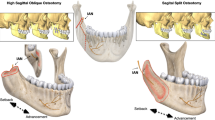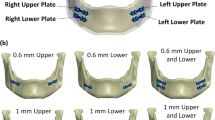Abstract
Purpose
The aim of the present study was to evaluate the four methods for bilateral sagittal osteotomy fixation.
Methods
In this study, 56 replicas of whole mandibles made of rigid polyurethane were used. After simulation of major advancement (11 mm) with clockwise rotation of the mandible (6o) in relation to the occlusal plane, the bone segments were fixed with plates and screws of the 2.0-mm system on both the right and left sides: group I, double “H” plate; group II, two mini-plates; group III, “hybrid technique”; and group IV, three bicortical screws in the “inverted L” pattern. The mandibles were submitted to load on the central incisors and right first molar.
Results
The mean value of group I was higher than those of groups IV and II in the displacement of 1 mm (F = 4.705; p = 0.010) with load on the incisor. The mean value of group III was higher than those of groups I and II in the displacement of 1 mm (F = 5.166; p = 0.007) and 3 mm (F = 5.166; p = 0.007). The mean value of group IV was higher than that of group II (F = 3.142; p = 0.044) with load on the molar.
Conclusion
Therefore, after the analyses, the hybrid technique was the one that showed the best results.


Similar content being viewed by others
References
Trauner R, Obwegeser H (1957) The surgical correction of mandibular prognathism and retrognathia with consideration of genioplasty. I. Surgical procedures to correct mandibular prognathism and reshaping of the chin. Oral Surg Oral Med Oral Pathol 10:677–689
Trauner R, Obwegeser H (1957) The surgical correction of mandibular prog- nathism and retrognathia with consideration of genioplasty. II. Operating methods for microgenia and distoclusion. Oral Surg Oral Med Oral Pathol 10:787–792
Dreiseidler T, Bergmann J, Zirk M, Rothamel D, Zoller JE, Kreppel M (2016) Three-dimensional fracture pattern analysis of the Obwegeser and Dal Pont bilateral sagittal split osteotomy. Int J Oral Maxillofac Surg 45:1452–1458
Dal Pont G (1961) Retromolar osteotomy for the correction of prognathism. J Oral Surg Anesth Hosp Dent Serv 19:42
Hunsuck EE (1968) A modified intraoral sagittal splitting technic for correction of mandibular prognathism. J Oral Surg 26:250
Bell WH, Schendel SA (1977) Biologic basis for modification of the sagittal ramus split operation. J Oral Surg 35:362–369
Epker BN (1977) Modifications in the sagittal osteotomy of the mandible. J Oral Surg 35:157
Wolford LM, Bennett MA, Rafferty CG (1987) Modification of the mandibular ramus sagittal split osteotomy. Oral Surg Oral Med Oral Pathol 64:146–155
Wolford LM, Davis WM Jr (1990) The mandibular inferior border split: a modification in the sagittal split osteotomy. J Oral Maxillofac Surg 48:92–94
Wolford LM (2000) The sagittal split ramus osteotomy as the preferred treatment for mandibular pronathism. J Oral Maxillofac Surg 58:310–312
Wolford LW (2015) Influence of osteotomy design on bilateral mandibular ramus sagittal Split osteotomy. J Oral Maxillofac Surg 73:1994–2004
Peterson GP, Haug RH, Van Sickels J (2005) A biomechanical evaluation of bilateral sagittal ramus osteotomy fixation techniques. J Oral Maxillofac Surg 63:1317–1324
Oba Y, Yasue A, Kaneko K, Uchida R, Shioyasono A, Moriyama K (2008) Comparison of stability of mandibular segments following the sagittal split ramus osteotomy with poly-L-lactic acid (PLLA) screws and titanium screws fixation. Orthodontic Waves 67:1–8
Yamashita Y, Otsuka T, Shigematsu M, Goto M (2011) A long-term comparative study of two rigid internal fixation techniques in terms of masticatory function and neurosensory disturbance after mandibular correction by bilateral sagittal split ramus osteotomy. Int J Oral Maxillofac Surg 40:360–365
Pereira Filho VA, Iamashita HY, Monnazzi MS, Gabrielli MFR, Vaz LG, Passeri LA (2013) In vitro biomechanical evaluation of sagittal split osteotomy fixation with a specifically designed miniplate. Int J Oral Maxillofac Surg 42:316–320
Oguz Y, Watanabe YER, Reis JM, Spin-Neto R, Gabrielli MA, Pereira-Filho VA (2015) In vitro biomechanical comparison of six different fixation methods following 5-mm sagittal split advancement osteotomies. Int J Oral Maxillofac Surg 44:984–988
Klein GBG, Mendes GCB, Ribeiro Junior PD, Viswanath A, Papageorge AM (2017) Biomechanical evaluation of different osteosynthesis methods after mandibular sagittal split osteotomy in major advancements. Int J Oral Maxillofac Surg 46:1387–1393
De Oliveira LB, Reis JMN, Spin-Neto R, Gabrielli MAC, Oguz Y, Pereira-Filho VA (2016) Mechanical evaluation of six techniques for stable fixation of the sagittal split osteotomy after counterclockwise mandibular advancement. Br J Oral Maxillofac Surg 54:573–578
Hammer B, Ettlin D, Rahn B, Prein J (1995) Stabilization of the short sagittal split osteotomy: in vitro testing of different plate and screw configurations. J Craniomaxillofac Surg 23:321–324
Van Sickels JE, Peterson GP, Holms S, Haug RH (2005) An in vitro comparison of an adjustable bone fixation system. J Oral Maxillofac Surg 63:1620–1625
Aymach Z, Nei H, Kawamura H, Bell W (2011) Biomechanical evaluation of a T-shaped miniplate fixation of a modified sagittal split ramus osteotomy with buccal step, a new technique for mandibular orthognathic surgery. Oral Surg Oral Med Oral Pathol Oral Radiol Endod 111:58–63
Sener I, Arici S, Bereket C, Tek M (2012 Sep) In vitro biomechanical evaluation of modified plating techniques for bilateral sagittal Split ramus osteotomy in mandibular advancement. J Craniofac Surg 23(5):1573–1576. https://doi.org/10.1097/SCS.0b013e31826100ec
Ulu M, Soylu E, Kelebek S, Dikici S, Oflaz H (2018 Feb) Comparative study of biomechanical stability of resorbable and titanium fixation systems after sagittal split ramus osteotomy with a novel designed in-vitro testing unit. J Craniomaxillofac Surg 46(2):299–304. https://doi.org/10.1016/j.jcms.2017.11.024
Brasileiro BF, Grempel RG, Ambrosano GM, Passeri LA (2009) An in vitro evaluation of rigid internal fixation techniques for sagittal split ramus osteotomies: advancement surgery. J Oral Maxillofac Surg 67:809–817
Sato FR, Asprino L, Consani S, de Moraes M (2010) Comparative biomechanical and photo-elastic evaluation of different fixation tech- niques of sagittal split ramus osteotomy in mandibular advancement. J Oral Maxillofac Surg 68:160–166
Ribeiro-Junior PD, Magro-Filho O, Shastri KA, Papageorge MB (2010) In vitro biomechanical evaluation of the use of conventional and locking miniplate/screw systems for sagittal split ramus osteotomy. J Oral Maxillofac Surg 68:724–730
Ochs MW (2003) Bicortical screw stabilization of sagittal split osteotomies. J Oral Maxillofac Surg 61:1477–1484
Shetty V, Freymiller E, McBrearty D, Caputo AA (1996) Experimental analysis of functional sta- bility of sagittal split ramus osteotomies se- cured by miniplates and position screws. J Oral Maxillofac Surg 54:1317–1324
Erkmen E, Simsek B, Yucel E, Kurt A (2005) Comparison of different fixation methods following sagittal split ramus osteotomies using three-dimensional finite elements analysis part 1: advancement surgery-posterior loading. Int J Oral Maxillofac Surg 34:551–558
Albougha S, Darwich K, Darwich MA, Albogha MH (2015) Assessment of sagittal split ramus osteotomy rigid internal fixation techniques using a finite element method. Int J Oral Maxillofac Surg 44:823–829
Rajchel J, Ellis E 3rd, Fonseca RJ: The anatomical location of the mandibular canal: its relationship to the sagittal ramus osteotomy. Int J Adult Orthodon Orthognath Surg 1986; (1): 37–47
Oguz Y, Saglam H, Dolanmaz D, Uckan S (2011) Comparison of stability of 2.0 mm standard and 2.0 mm locking miniplate/screws for the fixation of sagittal split ramus osteotomy on sheep mandibles. Br J Oral Maxillofac Surg 49:135–137
Bredbenner TL, Haug RH (2000) Substitutes for human cadaveric bone in maxillofacial rigid fixation research. Oral Surg Oral Med Oral Pathol Oral Radiol Endod 90:574–580
Saka B (2000) Mechanical and biomechanical measurements of five currently a sickeilable osteosynthesis systems of self-tapping screws. Br J Oral Maxillofac Surg 38:70–75
Kuik K, De Ruiter MHT, De Lange J, Hoekema A (2019) Fixation methods in sagittal split ramus osteotomy: a systematic review on in vitro biomechanical assessments. Int J Oral Maxillofac Surg 48(1):56–70
Acknowledgments
The authors thank the Fundação de Amparo à Pesquisa do Estado de São Paulo, FAPESP, for financing the present experiment under process no. 2017/19171-0 and Coordenação de Aperfeiçoamento de Pessoal de Nível Superior, Brasil (CAPES), Finance Code 001.
Funding
This study was funded by Fundação de Amparo à Pesquisa doEstado de São Paulo—FAPESP (grant no. 2017/19171-0) and Coordenação de Aperfeiçoamento de Pessoal de Nível Superior, Brasil (CAPES) (grant no. 001).
Author information
Authors and Affiliations
Corresponding author
Ethics declarations
Conflict of interest
The authors declare that they have no conflict of interest.
Additional information
Publisher’s note
Springer Nature remains neutral with regard to jurisdictional claims in published maps and institutional affiliations.
Rights and permissions
About this article
Cite this article
de Carvalho, P.H.M., Oliveira, S.d., Favaro, M. et al. Which type of method shows the best mechanical behavior for internal fixation of bilateral sagittal split osteotomy in major advancements with clockwise rotation? Comparison of four methods. Oral Maxillofac Surg 25, 27–34 (2021). https://doi.org/10.1007/s10006-020-00883-2
Received:
Accepted:
Published:
Issue Date:
DOI: https://doi.org/10.1007/s10006-020-00883-2




